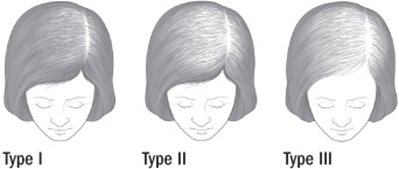Types of Alopecia
The most common form of hair loss in women is Androgenetic Alopecia also known as Female-pattern hair loss (FPHL)
- Clinicians use the Ludwig Classification to describe female pattern hair loss.
- Type I is minimal thinning that can be camouflaged with hair styling techniques.
- Type II is characterized by decreased volume and noticeable widening of the mid-line part.
- Type III described as diffused thinning, with a see-through appearance on the top of the scalp

- The visual hair shedding scale allows delineation between normal and abnormal shedding in women and girls with long hair.
- Grades 1-4 are considered normal
- Grades 5-6 represent abnormal, excessive shedding
- As 70% of patients with FPHL have excessive shedding, this scale may facilitate earlier diagnosis and treatment before the condition becomes irreversible.

Non-Patterned Types of Hair Loss
Alopecia Areata

It's an autoimmune condition, with symptoms of sudden hair loss that starts with one or more circular bald patches that may overlap.
Telogen Effluvium

Characterized by the thinning or shedding of hair typically catalyzed when the body goes through a traumatic event such as major surgery, childbirth or suffers from malnutrition.
Traction Alopecia

It is caused by localized trauma to the hair follicles from tight hairstyles that pull the hair over time.
Causes of Hair loss

Genetics

Androgens

Pregnancy

Nutritional Deficiency

Stress

Hair Cosmetic Treatments


